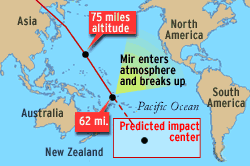This picture shows MIR's anticipated arrival zone. MIR did splash down within this predicted zone.
Courtesy of the Russian Space Agency
Space Stations Galore
News story originally written on March 29, 2001
This certainly is a special week in space station history! 15-year-old space station MIR entered
the Earth's atmosphere, breaking apart and burning up. MIR came down on March 23, 2001, ending its 2.1 billion mile voyage. Pieces of the station that did not burn up completely, plummeted into the Pacific
Ocean near Fiji. No injury or damage was done by these falling pieces. It is expected that some remnants of the station might wash up on shore of the Pacific Islands. Otherwise, the MIR space station is no more.
Russia's work on space stations is far from complete though. The 2nd crew of the International Space Station (ISS) is commanded by Russian Yury Usachev. The other 2 crew members onboard are American Flight Engineers Jim Voss and Susan Helms. This crew is just getting settled on the ISS. They spent a busy first week activating and testing the communications systems, robotic
workstations and scientific experiments onboard the station.
The ISS crew is already anticipating a visit from the Endeavour shuttle in late April. This Endeavour mission will deliver the Canadian-built robotic arm for the ISS and the Italian Space Agency-developed module named Raffaello. Raffaello includes more research equipment than any previous
station flight. This certainly is an international effort!
You might also be interested in:

It was another exciting and frustrating year for the space science program. It seemed that every step forward led to one backwards. Either way, NASA led the way to a great century of discovery. Unfortunately,
...more
The Space Shuttle Discovery lifted off from Kennedy Space Center at 2:19 p.m. EST, October 29th. The sky was clear and the weather was great as Discovery took 8 1/2 minutes to reach orbit for the Unitied
...more
A moon was discovered orbiting the asteroid, Eugenia. This is only the second time in history that a satellite has been seen circling an asteroid. A special mirror allowed scientists to find the moon
...more
Will Russia ever put the service module for the International Space Station in space? NASA officials are demanding an answer from the Russian government. The necessary service module is currently waiting
...more
During a period of about two days in early May, 1998, the ACE spacecraft was immersed in plasma associated with a coronal mass ejection (CME). The SWICS instrument on ACE, which determines unambiguously
...more
J.S. Maini of the Canadian Forest Service has referred to forests as the "heart and lungs of the world." Forests reduce soil erosion, maintain water quality, contribute to atmospheric humidity and cloud
...more
In late April through mid-May 2002, all five naked-eye planets are visible simultaneously in the night sky! This is includes Mercury which is generally very hard to see because of its proximity to the
...more















